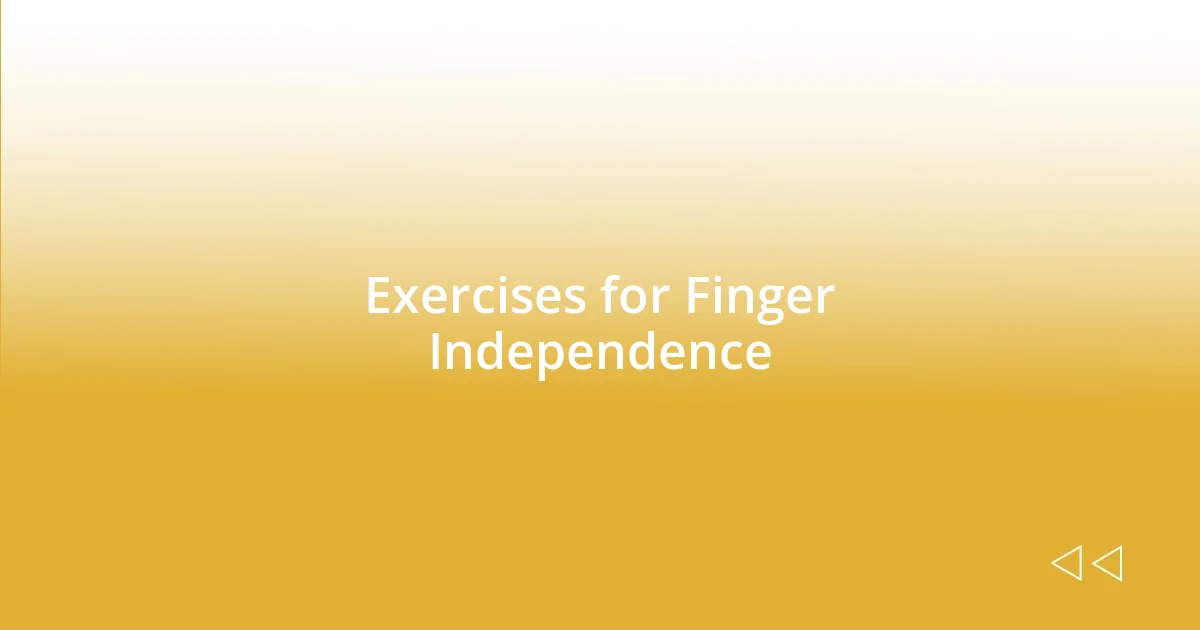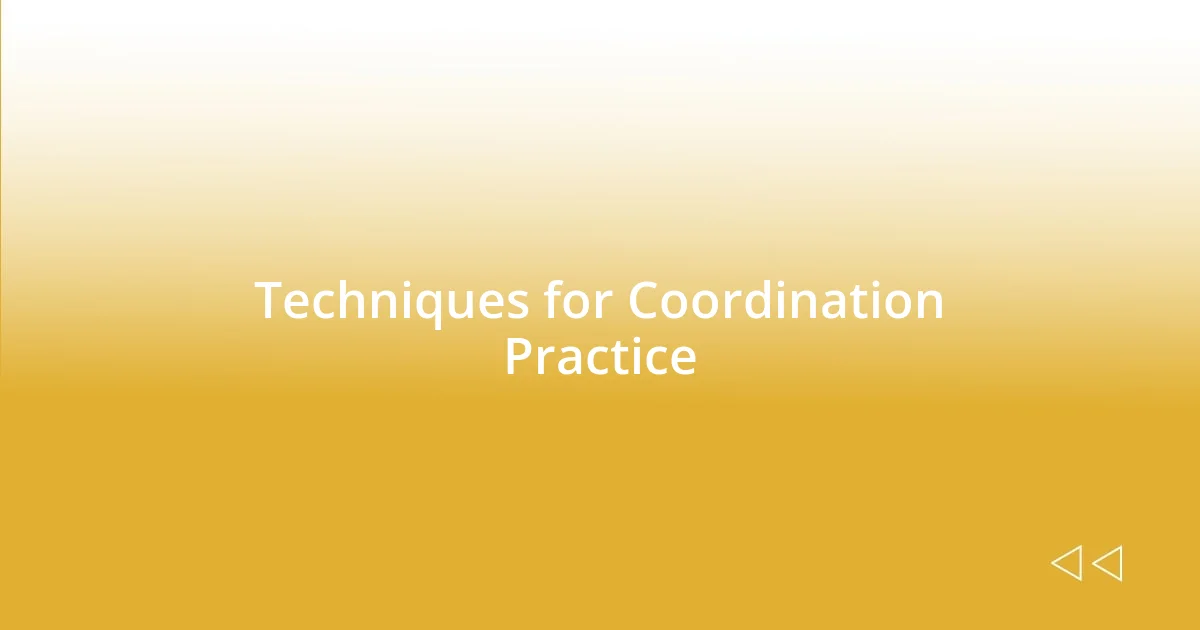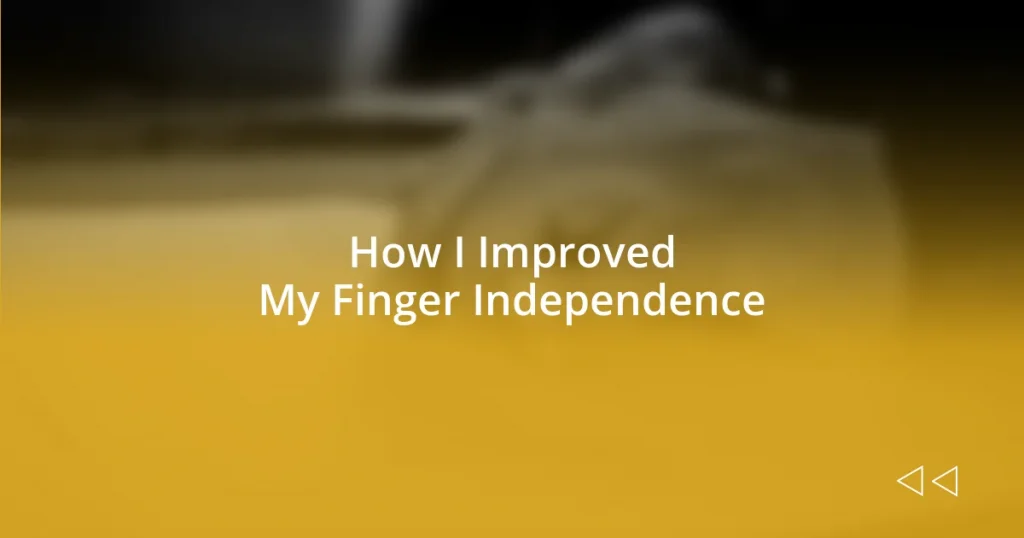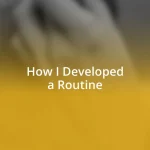Key takeaways:
- Developing finger independence enhances overall motor skills and musical expression, positively impacting activities such as typing and daily tasks.
- Consistent practice of specific exercises, including finger drills and stretches, significantly improves dexterity and coordination.
- Tracking progress and setting achievable goals fosters motivation and helps in overcoming challenges, enhancing the overall learning experience.

Understanding Finger Independence
Finger independence is not just an abstract idea; it’s a skill that significantly impacts how we play instruments or even type. I remember when I first tried playing scales on the piano. My fingers felt like they were in a tangled mess, all vying for the same note. Have you ever felt that way? It’s frustrating when you can hear the music in your head but can’t quite get your fingers to cooperate.
As I practiced, I learned that developing finger independence requires patience and consistent effort. There were days when my fingers seemed stubborn, refusing to follow my mind’s direction. I often wondered if I’d ever overcome that initial struggle. However, setting small goals really helped me to visualize progress, like mastering a challenging passage one finger at a time.
Over time, I found that engaging each finger separately not only improved my musical abilities but also heightened my overall dexterity. This journey taught me the importance of intentional exercises, such as finger drills or using objects to isolate movements. Have you found certain exercises effective? The more I focused on those small, deliberate movements, the more fluid my playing became, and that sense of accomplishment was truly exhilarating.

Importance of Finger Independence
Finger independence is crucial for enhancing overall motor skills. I vividly recall the first time I tried to play a simple melody while simultaneously managing different rhythms with each finger. It felt like a juggling act! This struggle underscored for me how vital it is to train each finger to move independently, allowing for greater expression in music and finer control in everyday activities.
As I delved deeper into mastering finger independence, I noticed a significant impact on my typing speed and accuracy. It may seem surprising, but investing time to strengthen my fingers not only improved my piano playing but also made me more efficient at the computer. Have you experienced this unexpected benefit, too? It’s fascinating how honing one skill can inadvertently enhance another.
Developing this skill takes time, but the rewards are immense. I still remember the joy of confidently playing complex pieces without worrying about the coordination of my fingers. It is a small victory that has empowered me in many areas of my life, from music to daily tasks. The journey to gain this independence has taught me that every little improvement counts, leading to a more confident and versatile self.
| Aspect | Importance of Finger Independence |
|---|---|
| Musical Expression | Enhances ability to play complex pieces with clarity. |
| Daily Tasks | Improves dexterity in activities like typing and gaming. |
| Coordination Skills | Develops better hand-eye coordination through targeted exercises. |
| Confidence | Boosts self-esteem by overcoming initial struggles in skill development. |

Exercises for Finger Independence
I discovered various exercises that genuinely helped in gaining finger independence, and they can be both simple and fun. For example, I enjoyed using a stress ball for squeezing exercises, where I’d focus on curling my fingers individually. The sensation of mastering that movement was immensely satisfying, especially when I could feel each finger growing stronger.
Here are some exercises that can help improve finger independence:
- Finger Tapping: Place your hand flat on a surface and tap each finger one at a time, pressing down firmly and lifting it slowly.
- Finger Lifts: Keep your fingers on a flat surface and practice lifting one at a time while the others remain down.
- Isolation with Objects: Use small objects like marbles; pick them up with each finger individually to build strength and coordination.
- Scale Practice: Play scales but assign specific fingers to each note, resisting the urge to let them all move together.
- Finger Rolls: Practice rolling a pen or pencil between your fingers; it’s surprisingly engaging and builds dexterity.
I can’t stress enough how consistency with these exercises transformed my playing. One day, while doing my finger lifts, I realized I was no longer hesitating between notes during practice. That moment of clarity made me appreciate how far I had come. Have you had a similar realization during your practice? It’s those little breakthroughs that form the backbone of our growth—unexpected yet deeply fulfilling.

Stretches for Improved Flexibility
When it comes to stretches for improved flexibility, I found that incorporating simple hand and finger stretches made a noticeable difference in my overall comfort while playing. One stretch I often do involves gently pulling back each finger with my opposite hand, holding the stretch for about 15-20 seconds. I remember feeling such a release in tension during those moments—it’s a small act, but the relief it brings is almost euphoric and sets me up for a productive practice session.
Another effective stretch includes the classic wrist stretch. By extending my arm in front of me with my palm up and gently pulling back on my fingers, I could really feel the stretch all the way through to my forearm. This one was particularly eye-opening for me; I once got so caught up in my practice that I neglected to stretch, and my fingers felt tight and clumsy. Now, I make it a point to include this stretch, not just for flexibility but also to prevent any discomfort that could disrupt my progress.
I can’t forget to mention the joy of doing the “spider stretch,” where you spread your fingers wide and gently alternate pushing down each finger while keeping the others extended. The first time I tried this, my fingers felt like they were dancing on their own. Have you ever felt that wonderful sensation when your fingers come alive through a stretch? It’s those little moments that remind me to enjoy the journey of mastering my craft and embracing the process of improvement.

Techniques for Coordination Practice
Practicing finger coordination is truly a transformative journey. I found that incorporating rhythmic finger exercises not only improved my dexterity but also added a playful element to my practice. For instance, I often engage in a game where I tap my fingers to a metronome, emphasizing different fingers on the beat. It’s surprisingly satisfying to feel that rhythmic flow, and it pushes you to be mindful of each finger’s movement. Have you tried this? The more you play with rhythm, the more natural it becomes.
Another technique I leaned into was the use of a finger independence app on my phone. It might sound a little techie, but following along with dynamic exercises provided by the app really worked for me. Without even realizing it, I started looking forward to my practice sessions as if they were a fun challenge rather than a chore. Each week brought new exercises that kept me engaged and eager to improve. Who knew that a bit of digital assistance could also build my confidence along the way?
Finally, I can’t recommend mindful breathing while practicing enough. As I focused on taking deep, calming breaths, I noticed that not only did my fingers become more relaxed, but my mind did too. This mindfulness allowed me to approach each exercise with curiosity rather than frustration when it didn’t go perfectly. Have you ever noticed how your mindset impacts your practice? It’s a game-changer to remember that improvement is a journey, and appreciating each small victory makes the process so much more enjoyable.

Tools and Resources for Training
When it comes to tools for finger independence training, I’ve found that using finger exercise gadgets can be remarkably effective. One of my favorites is a simple finger strengthener, which consists of rubber bands designed to stretch across each finger. They’re not only inexpensive but add a playful touch to my routine. I remember the first time I used one—I could hardly believe how quickly my fingers began to feel stronger and more independent. Have you experienced that satisfying burn in your fingers that reminds you you’re making progress?
Another resource that has made a significant impact on my training is an online course dedicated to finger independence. I took the leap when I stumbled upon a series of video tutorials, and it felt like having a personal coach on demand! The course not only provided structured exercises but also insight into why each movement mattered. I often catch myself replaying my favorite lessons, which is a testament to how engaging this content can be. Isn’t it amazing how learning from others can elevate our practice?
Lastly, I can’t overlook the value of practicing with an instrument that emphasizes finger independence, like a fingerstyle guitar or a piano. I invested in a beginner’s guide to fingerstyle guitar, and the moment I started playing those intricate patterns, it was like unlocking a new level of expression. The joy of creating music with my own fingers was beyond words. Have you ever felt that rush of excitement when your fingers dance over the strings in perfect harmony? Harnessing the right tools has certainly shaped my journey, making it not only productive but deeply fulfilling.

Progress Tracking and Goals
Tracking progress and setting goals has been a game-changer for me in my finger independence journey. I started by keeping a simple journal where I noted down my daily exercises and any improvements I felt. Looking back at those entries felt like unearthing little treasures—the moment I could finally hit a challenging chord or smoothly execute a particularly tricky sequence. Isn’t it fascinating how tangible records can boost motivation?
As I advanced, I began setting specific goals for myself. For instance, I aimed to master one new exercise each week and celebrate that accomplishment. One week, I was determined to tackle a fingerpicking pattern that had seemed impossible. By breaking it down into smaller sections and tracking my practice hours, I watched my progress unfold like a little flower blooming. Have you ever had that moment when you surprise yourself with what you can achieve?
There were times I felt disheartened because the journey wasn’t linear, and that’s totally normal. I learned to reflect on my progress rather than seek perfection. By charting not only my successes but also the challenges I faced, I realized those moments of frustration were part of growing. It helped me shift my mindset—what if setbacks were merely stepping stones to greater finger independence? This transformation in thought can make all the difference, wouldn’t you agree?















